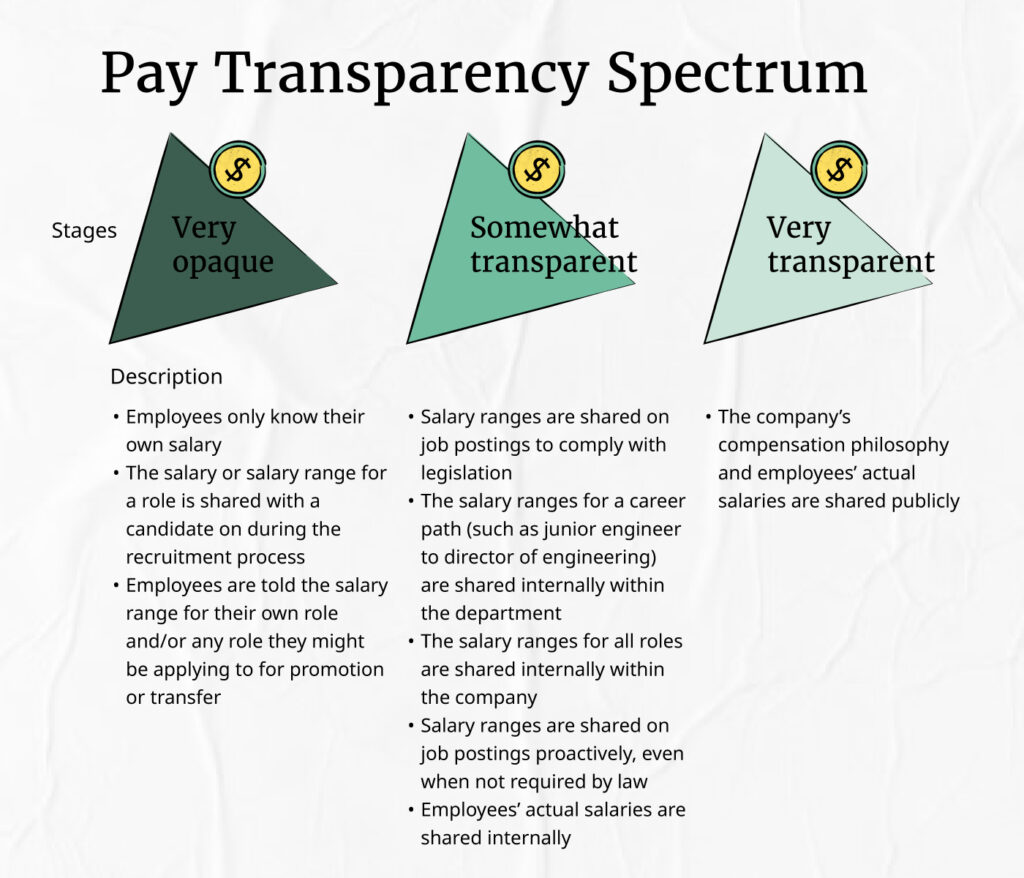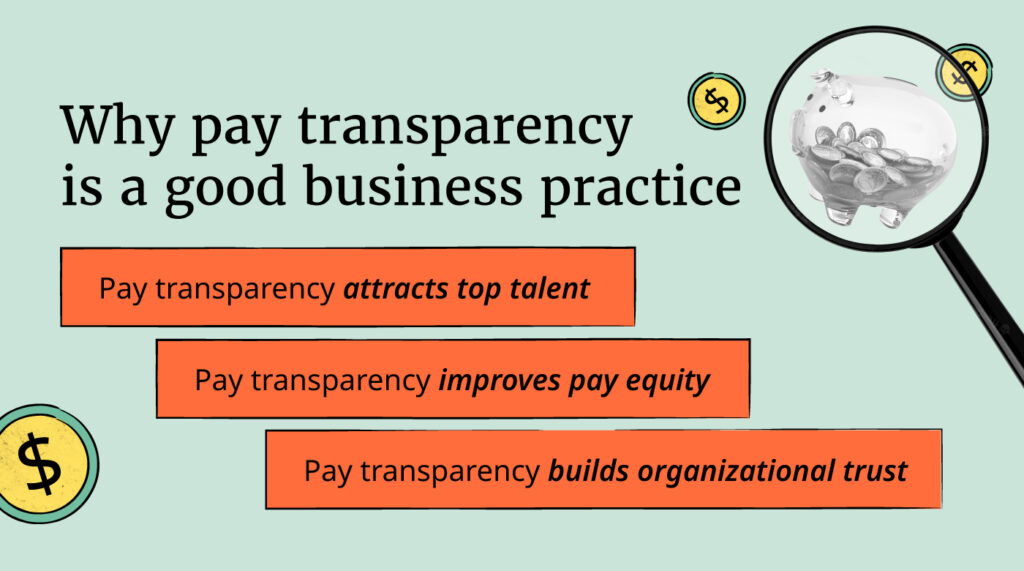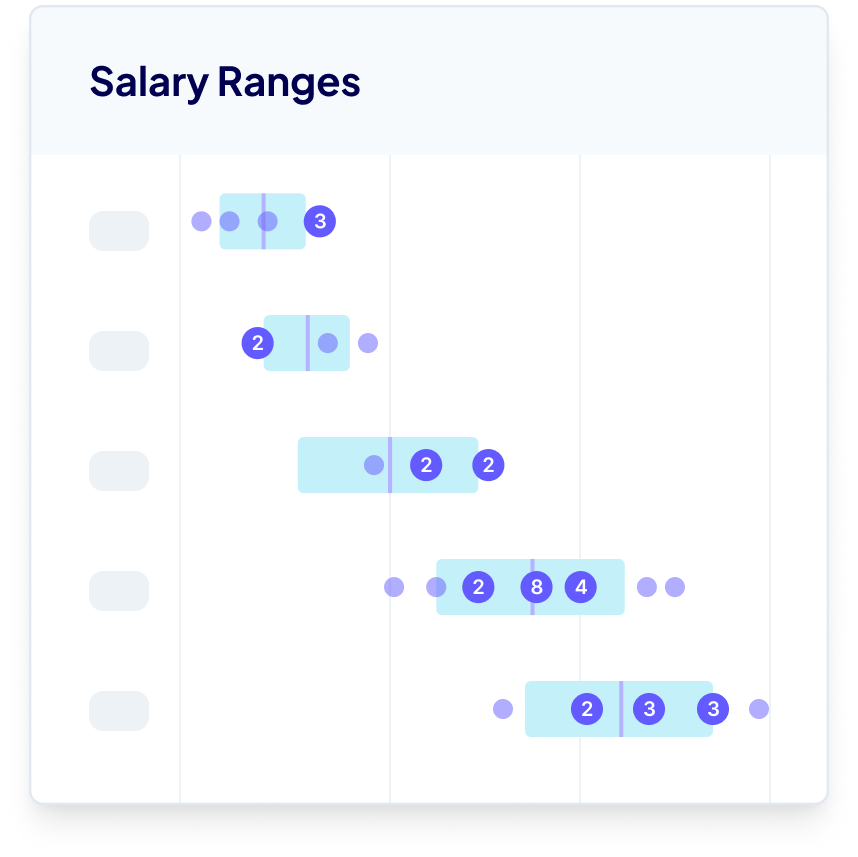Pay transparency is the next big shift that will define the future of work.
In a recent survey, 85% of upcoming and recent grads said they were less likely to apply for a job if the salary was not disclosed in the job posting. As Gen Z enters the workforce, they're pushing forward more open and transparent conversations about pay. And they’re not the only ones.
In the past few years, we’ve seen an explosion of salary data being shared openly: from crowd-sourced sites like Glassdoor and Levels.fyi, to salary spreadsheets within private networking groups, to the rise of pay transparency advocates on LinkedIn, Instagram, and TikTok.
Now, new pay transparency laws are coming into effect across the United States and Canada, mandating that companies start sharing salary ranges internally with employees and externally on job postings.
All of this leaves companies scrambling to figure out how pay transparency will impact their employees, their business, and their bottom line.
What is pay transparency?
It’s a common misconception that pay transparency means disclosing all your salary ranges to the public in one big announcement. Pay transparency is actually a spectrum of actions that your company takes to communicate about pay with current employees, candidates, and the public on an ongoing basis.
At the least transparent end of the spectrum, a company may share very little about the "why" and "how" behind pay. Employees only know their own salary, and candidates may not find out the salary for a role until a later stage of the recruitment process.
On the other end of the spectrum is the kind of radical transparency where all salaries are shared openly, similar to how the salaries of U.S. government employees are publicly available.
Most companies fall somewhere in between these two extremes. They may share salary ranges without sharing the actual salaries of individual employees. They may share some aspects of their compensation philosophy, such as whether they pay differently depending on location, but not share other aspects, like how their salary ranges are positioned relative to competitors.
You don’t have to go all the way to radical transparency to achieve great business results. Increasing your level of pay transparency, even by a few steps, can have a widespread positive impact on your company.

Why pay transparency is good business practice

If you get it right, pay transparency can be one of the most powerful pillars of your overall compensation strategy. It can help you hire the best people, retain them for the long term, and create a positive and productive work culture.
Pay transparency attracts top talent
Pay transparency is a powerful advantage in a competitive talent market. Even though some talent acquisition professionals fear that publicly posting a range may hamper their efforts to “sell” candidates on their companies (i.e., candidates not applying for a role based on the posted salary range alone), survey data shows that job postings with salary ranges actually attract up to 90% more job applicants.
In some jurisdictions, such as New York and California, companies of a certain size are legally required to share salary ranges on job postings. The introduction of this legislation, in two of the most populated states, has prompted other states and provinces, and even the federal government, to consider enacting similar laws.
These laws create a ripple effect: many companies have started sharing their salary ranges proactively, before it is required by law, to attract more applicants.
The result is that open conversations about pay are becoming more common before and during the recruitment process. Companies that aren’t prepared to have these conversations risk losing out on great candidates.
Pay transparency improves pay equity
Studies have shown that pay transparency has the power to close pay gaps based on protected characteristics like gender, ethnicity, disability status, and sexual orientation.
When a company is transparent about its pay practices, it becomes easier for the employer and employees to identify and address any pay disparities. It creates pressure for the company to address the inequity and makes it easier for employees to speak up and advocate for fair pay.
In the absence of transparency, employees may find out about a pay gap through personal conversations with coworkers, online message boards, or crowd-sourced salary data sites. These backchannel conversations can foster resentment, gossip, and productivity problems, and can even expose you to legal risk and damage your employer brand.
Pay transparency may also bolster your company’s diversity, equity, and inclusion efforts. Women and people of color prefer to work at organizations that are actively committed to fair pay and equality.
Pay transparency builds organizational trust
Trust between employers and employees is one of the key performance indicators of a company’s success. According to the Harvard Business Review, employees at high-trust organizations are more productive, more collaborative, happier, and stay at their companies for longer.
Pay transparency can have an immensely positive impact on organizational trust. It gives the company and its managers the opportunity to openly communicate with employees about how and why pay is determined, and what an employee can do to grow in their role and compensation.
This reassures employees that their company is trying to be thoughtful and equitable in its approach to pay, and can result in a greater sense of employee satisfaction around pay.
How to overcome the barriers to pay transparency
Even though pay transparency is currently seeing a rising tide of support, and has so many positive business impacts, it can still be an intimidating idea. Companies often worry that their salaries are not ready for public scrutiny, and might reveal pay gaps and other risks within the organization.
It’s important to remember that pay transparency is a spectrum. There are small, incremental steps that you can take to get ready and reap some of the benefits of better communication around pay.
Build a consistent and equitable pay structure
The first step to greater transparency is to get the foundations right internally.
Start by documenting your comp philosophy. How does your company pay relative to the market? What are your guidelines for how pay decisions should be made? Your compensation philosophy serves as a source of truth to answer these questions.
Then create a pay structure, which serves as a framework of job levels and salary ranges for all the positions at your company. Many companies will have some elements of this structure already in place, but, if you’re building it from scratch, start with your first job leveling framework.
Make a plan to fix any inconsistencies
Once you have your pay structure in place, you’ll need to assess how your actual employee salaries stack up against your intentions. You may find that you have employees who are significantly above or below your ranges. You might even uncover a pattern of bias or a pay equity issue.

Make a plan to remediate these issues. For example, you might choose to prioritize pay increases for high-performing employees who are below their salary to bring them internal equity with their colleagues. Alongside that, it may make sense to introduce guardrails for hiring, so that new offers are made in a way that is consistent with your existing employees’ pay.
These issues were not created in a day, and it’s likely that it will take more than one salary review cycle to fix them. However, doing so will ensure the long-term success of your compensation management strategy and prepare you for any upcoming pay transparency requirements.
Prepare managers and recruiters for tough comp conversations
Pay transparency is all about fostering more open and honest communication about pay, which can be a sensitive and emotional topic.
Your company’s HR department or executive team might do an initial rollout of any pay transparency initiatives. But, if employees or candidates have questions or concerns going forward, they are most likely going to have these conversations with their immediate manager or their recruiter. That makes managers and recruiters the frontline advocates for your compensation and pay transparency policies, and they need to be set up for success.
This will include providing them with detailed information about the company's compensation policies and practices, training them on active listening and having difficult conversations, and educating them on any legal or compliance requirements around pay transparency.
The pay transparency movement is gaining momentum
By the end of 2023, roughly one in four American employees will be covered by some sort of pay transparency legislation, and that number will only increase.
Getting ready to be transparent can be a long process, but the benefits far outweigh the costs. By improving your level of transparency, you can improve your company’s pay equity and DEI outcomes, attract top talent, and engage and retain your employees for the long term.
How ready is your company to contend with pay transparency requirements? Are you planning to put more structure around your pay or roll out new transparency initiatives this year, even if you’re not mandated to do so?
Many organizations use compensation management software to help them with tasks such as calculating salaries, undertaking pay equity audits, and aligning pay with performance.
Share your plans, opinions, and additional advice in the, and subscribe to the People Managing People newsletter to receive regular content to help you progress in your career and build healthy, productive organizations.
Related Listen:


